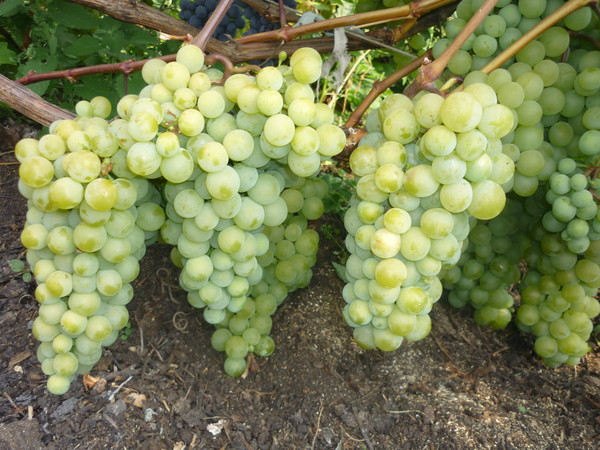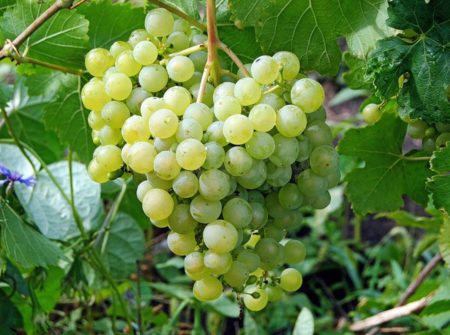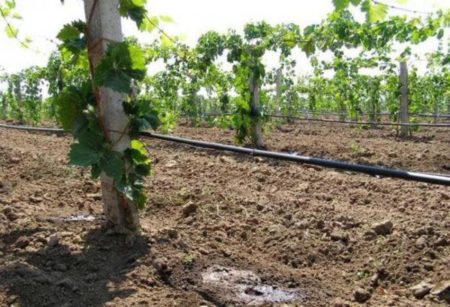
The famous grape varieties include Muscat white. The exact origin of the variety is unknown, but it is considered one of the oldest representatives of grapes. Muscat is a typical representative of grapes that are grown for processing, its main purpose is winemaking.
Content
Characterization and description of the variety

The variety belongs to the eastern group of grape crops. Presumably, he was bred in Egypt or Syria. Muscat was most widely spread in countries with a warm climate: in Italy, Spain, Romania, Bulgaria, Hungary, France and the USA. In Russia, the variety is grown less often due to insufficient frost resistance. Often the grapes do not have enough time for complete ripening. For aging, it takes from 140 to 150 days, and in most regions in mid-October the temperature drops to almost zero. Muscat is grown in the south of the country, where it has enough sun and the number of warm days.
Muscat has small white clusters, the average weight is 200-300 g. The mass of the cluster rarely exceeds 400 g. The berries are neat, a bit small. The skin color is light yellow with a beautiful amber tint. The fruits are rounded in shape. The grapes are sweet to taste, the fruit has a high sugar content of 20 g / l, but a little acid - about 6-7 g / l. The proportions of sugar content and acidity may vary depending on the specific growing conditions of the culture.
Nutmeg is grown on an industrial scale, and vintage dessert wines are made from the obtained crop, added to champagne, juices. The variety gives the drink a citrus flavor in combination with a rose. Berries are quite suitable for fresh consumption. Muscat can be found on the market for free, especially in markets. Productivity makes from 60 to 120 centners from one landing hectare. The variety enters maximum fruiting when it reaches maturity at 6-7 years.
Seedlings initially have erect shoots with slightly lowered tops. The leaves are serrated, bright green. Grapes begin to bloom at the beginning or in the second half of summer; they do not need pollinators. There are not so many fruitful shoots - 50-60% of the vine quickly stretches, its length easily reaches 5 meters or more. Pruning varieties need regular at least 1 time per year. Shoots are shortened by 5-8 eyes.
White nutmeg does not have good immune qualities and, if improperly maintained, is often sick. Especially dangerous for grapes are mildew, oidium, anthracnose. The rainy season and cloudy weather can cause gray rot to appear on the shoots. On clusters, a bunch of leaves is sometimes progressing. Grapes must be processed 2-3 times a season with fungicidal agents.
Muscat is loved for the following positive qualities:
- stable yield;
- easy care;
- high keeping quality of fruits;
- good transportability;
- universal purpose.
Gardeners who choose a planting variety may have to deal with negative aspects:
- poor immunity to viral diseases and fungal spores;
- long ripening period;
- low frost resistance.
All problems associated with the cultivation of Muscat are easily solved if the plant is provided with proper and regular care.
Landing

Features of Muscat planting are the right choice of place. If there is a hill in the summer cottage, then it will be very useful for growing grapes.Low places, especially hollows, should be avoided, so the plant will receive less sun, and the soil will sour more. Clay soil for Muscat is not acceptable. If the clay content is clearly exceeded, then add river sand, peat to the ground.
Grape seedlings are prepared for planting in mid-April, pre-process the root system in a stimulating additive. Potash fertilizers are introduced into the soil in advance, the variety responds well to the microelement from the first year, and in further care, potash supplements are used to increase yield. After planting, the ground should be well moistened and mulched to maintain water balance in the ground with straw or sawdust.
Care

Caring for Muscat is practically no different from caring for another grape variety, but still has a number of features. They are not complicated, but require a familiarization. You should not neglect the care, otherwise the crop may be ruined, and the plants will become ill. Muscat growing features include:
- infrequent watering. Possibly, drip technique is used, but if there is no possibility, then the trench method of irrigation;
- mulching. The earth needs to be mulched after each watering. The ideal composition of mulch is peat with humus, taken in equal proportions;
- regular weeding from weeds. Excess vegetation takes part of the nutrients from the soil and interferes with the growth of the vine;
- preventive treatment against pests and diseases. Spend before flowering with Bordeaux liquid, vitriol, you can use Fitosporin, Topaz.
The condition of the grapes is constantly monitored. A healthy plant has active shoot formation; there should be no signs of infection on the leaves - plaque, inclusions, cracks. If changes have appeared, immediately find out the cause and eliminate it.
Wintering
When growing grapes in the south, sheltering plants is not necessary. The variety will calmly survive the winter without mulching. If the variety is still planted in the region where winter comes in November, then shelter for it is done carefully. It is advisable to make a greenhouse for the vineyard for the winter. The usual mulching of the root system and vines with straw is also suitable. Lapotnik, pine branches are placed on straw, and on top of the ridge they are covered with tarpaulin, celluloid or any waterproof material. The grapes are not opened until April, when the ambient temperature will take a positive range.
Gardeners reviews
Valentine from Anapa He speaks:
“Muscat is the first grape variety that I started growing in my garden. Ripening occurs in 4 months, the berries ripen slowly, but evenly. The taste of fruits allows you to use them for cooking jam, making juices, of course wine. Every spring, after wintering, grapes are fed a nitrophos. He is rapidly gaining green mass, and the shoots are actively blooming. "
Antonina from Krasnodar Territory writes:
“My grapes are already 8 years old, and he continues to bear fruit in great numbers. Berries are a bit small and with a bone. The variety is unpretentious in care, but reacts to frequent watering. In no case should you fill the plants, otherwise rot will form, and the taste of the berries will deteriorate. It is better to refrain from watering during fruiting. ”

 Non-covering winter-hardy grape varieties for Moscow region
Non-covering winter-hardy grape varieties for Moscow region How to keep the vine in winter
How to keep the vine in winter When can I transfer grapes to another place in the fall
When can I transfer grapes to another place in the fall How to cover and prepare grapes for the winter in the suburbs
How to cover and prepare grapes for the winter in the suburbs